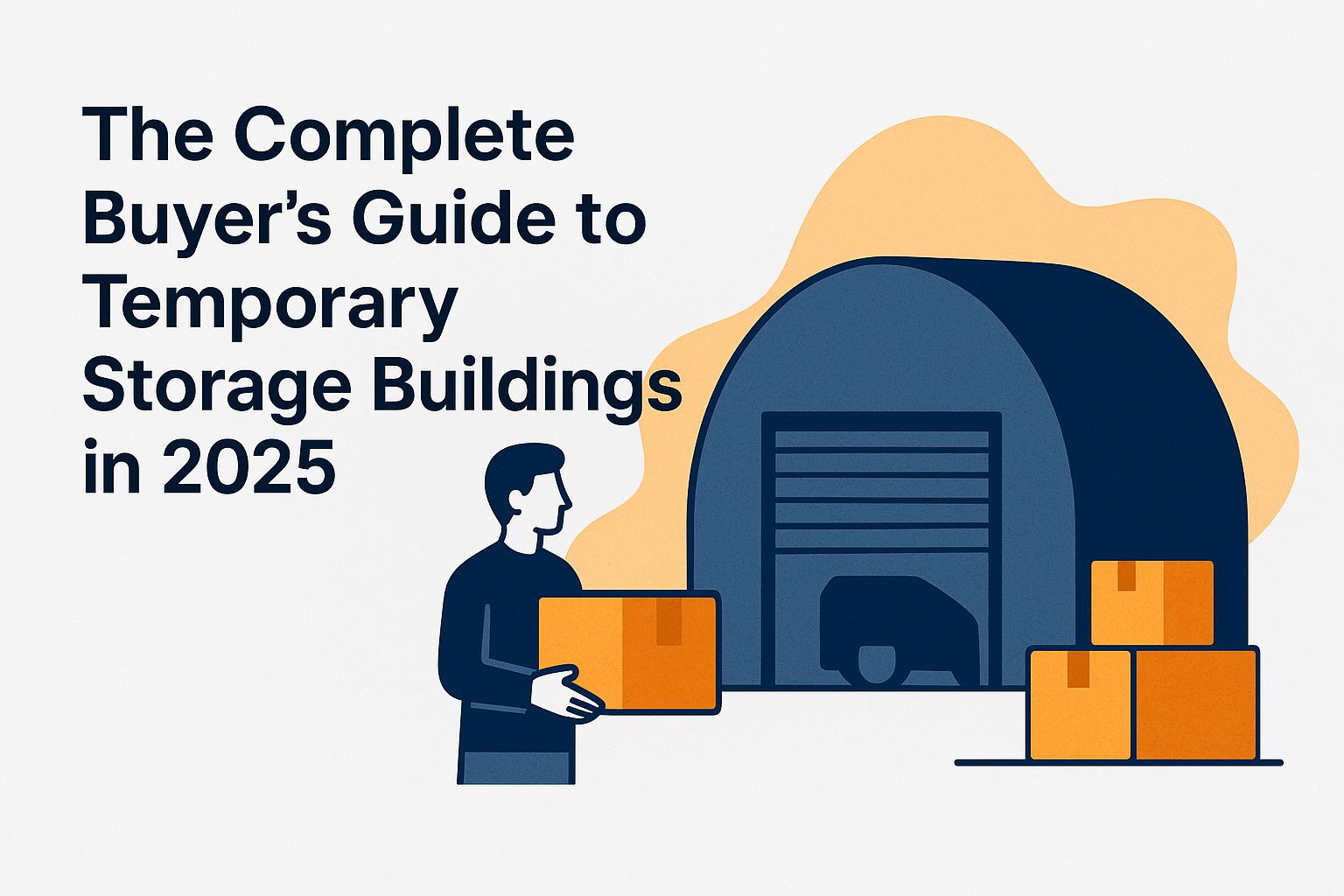
Need extra space without the commitment? Temporary storage buildings are an excellent choice for flexible needs, providing a budget-friendly storage option. When looking at options in 2025, it’s helpful to know the types, benefits, and key features. From fabric structures to modular solutions, learn what fits your budget and space requirements by exploring 2025 trends in storage facility options. Also, get important advice for comparing brands and finding great deals. Find out how to choose the best option for your storage needs!
What are Temporary Storage Buildings?
A buyer’s guide can help you understand the choices available for temporary storage buildings.
Temporary storage buildings are structures designed for short-term use, often constructed from materials like fabric or metal, providing ample space for storage needs.
Common examples include portable storage units like those from PODS, which can hold furniture during home renovations, or container units used at construction sites to store tools and materials securely.
These buildings are also ideal for events; for instance, companies may rent tent-like structures to store equipment and supplies during festivals, addressing seasonal storage needs.
Using a safe anchor system can make tents steadier in windy weather. This helps keep your items secure while the tent is in use.
Benefits of Using Temporary Storage
Look into rental storage spaces for convenient access and options.
Using temporary storage can save you up to 30% compared to traditional storage solutions, while offering flexibility and quick access to your items.
Many businesses use temporary storage options during peak seasons, relying on portable containers. For instance, a retail store might rent a PODS container to hold excess inventory during the holidays, ensuring they have space for new arrivals.
This method cuts costs and keeps things organized. Tools like SpareFoot can help you find cheap short-term storage options nearby, making it easier to increase your space when needed, allowing efficient use of city storage trends.
Think about using simple inventory tracking apps like Sortly. It lets you quickly find stored items and improves efficiency.
Types of Temporary Storage Buildings:
From modular storage units to state-of-the-art outdoor storage buildings.
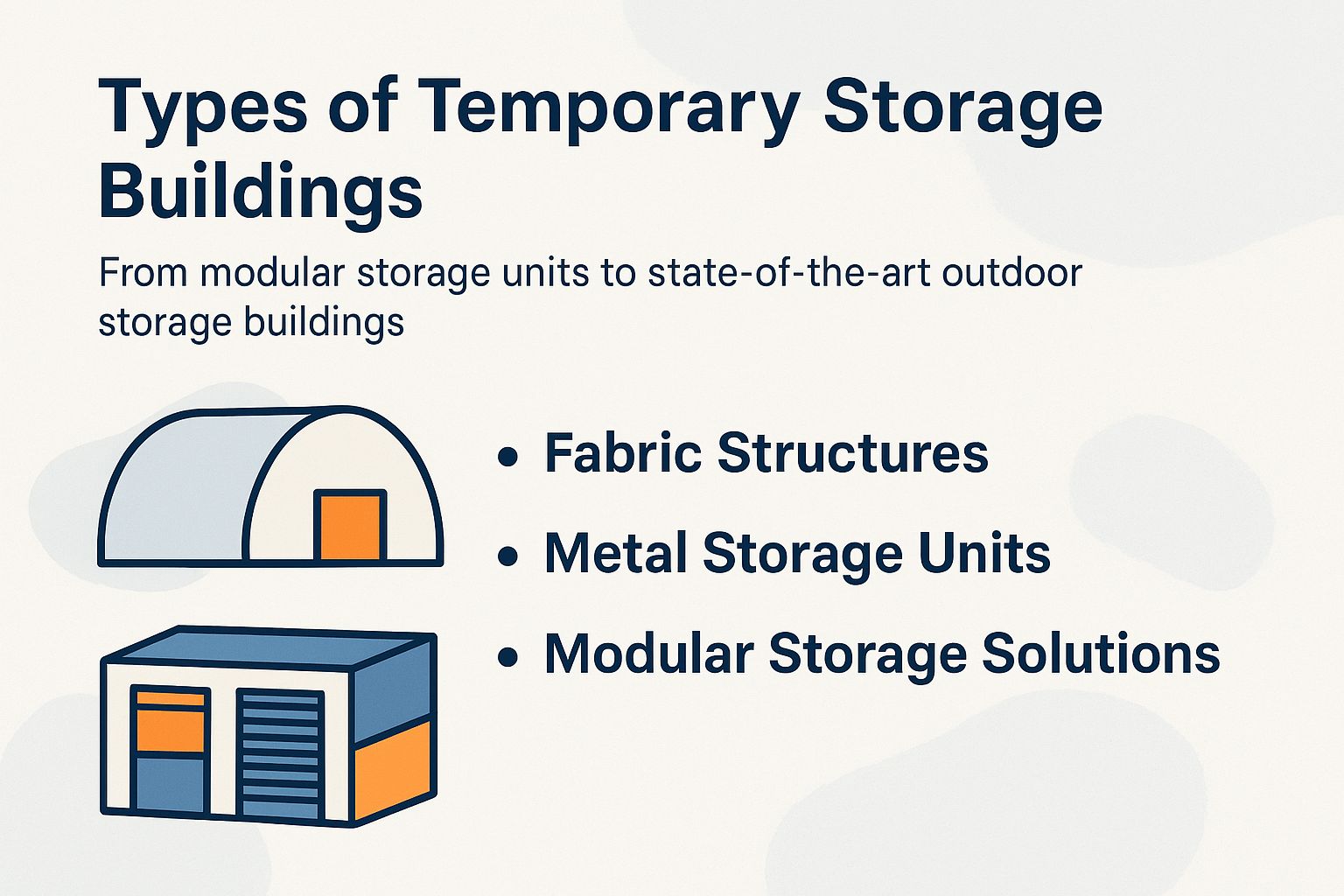
There are different kinds of temporary storage buildings, each designed for specific needs, materials, and uses. Those interested in how these structures can be utilized might find it informative to explore the top 6 uses for portable metal buildings in 2023.
Fabric Structures
Fabric structures, such as tension fabric buildings, are lightweight and can be set up quickly, often used for events or agricultural storage.
These structures offer several advantages: they are easy to move, which simplifies relocation, and they can be set up fast, significantly reducing the time needed to prepare for events.
Key manufacturers like ShelterLogic provide a range of options; for example, a 20×40 ShelterLogic tent can cost around $5,000. Other brands, such as FabriTec and ClearSpan, also offer durable buildings suited for various needs and conditions.
By investing in a high-quality fabric structure, you gain both flexibility and resilience, ideal for temporary or seasonal use.
Metal Storage Units
Metal storage units are durable and secure, ideal for extended use and harsh weather conditions.
Typically costing between $1,500 and $10,000, these units come with various security options like reinforced doors, electronic locks, and surveillance systems.
They are commonly used for storing vehicles, tools, or equipment, catering to both personal and business needs.
For instance, a 10×20 storage unit can protect classic cars from the elements, while a larger commercial-grade unit can securely house heavy machinery.
Think about features such as ventilation or fire resistance to keep your important items safe and in good condition.
Modular Storage Solutions
Flexible storage solutions let you change how space is used, which makes them practical for different storage needs in places like shops and building areas.
For instance, Container Solutions offers stackable containers starting at around $2,000, ideal for temporary storage needs, while PODS provides portable storage units for both moving and home storage, with prices beginning around $100 a month depending on location.
These solutions can change to fit various project sizes or inventory types, improving storage.
Many companies select these options to provide quick access, decrease clutter, and efficiently use space while considering upcoming needs.
Key Considerations Before Purchasing
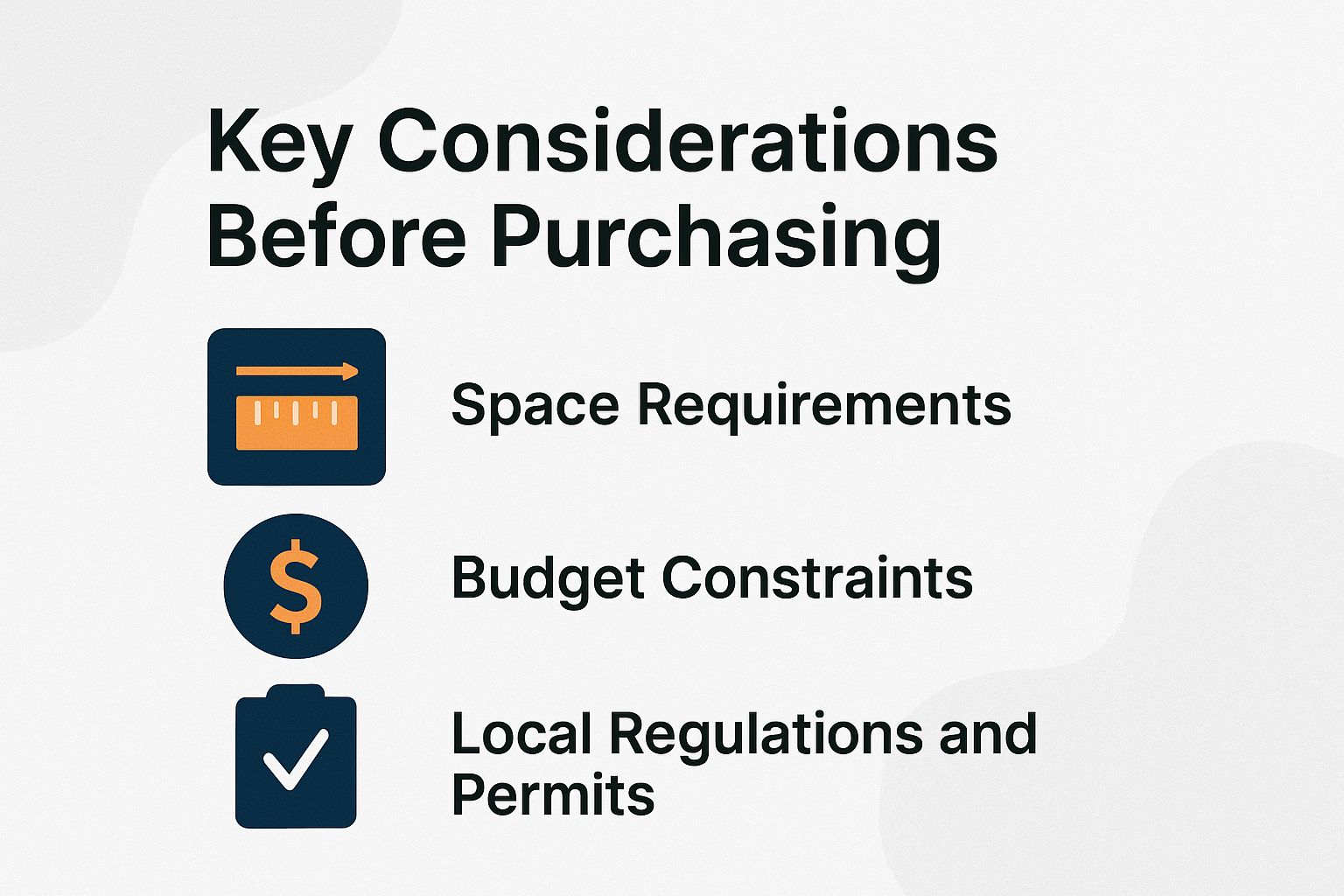
Understand the importance of zoning regulations and installation process for seamless setup.
Before buying a temporary storage building, consider different factors to make sure it fits your specific needs. For an extensive analysis of this process, our comprehensive guide on buying a portable office building delves into essential considerations.
Space Requirements
Consider available space and weight capacity for optimal organization.
Evaluating how much room you need is important; buildings usually vary from 100 to 1,200 square feet based on what is stored inside.
To correctly assess what you need, take these actions:
- First, measure the dimensions of each item you intend to store.
- Next, think about accessibility; make sure there is enough space for workers to move around safely.
- Familiarize yourself with local zoning restrictions, which can dictate how much space you need for different types of goods.
- For instance, if you’re storing equipment and inventory, you may require more square footage than residential storage.
Keeping these factors in mind will help you choose the right building size.
Budget Constraints
Look into payment plans and lease agreements to help manage your budget more effectively.
Creating a budget is important because temporary storage buildings can cost between $1,500 and $20,000, depending on their size and the materials used.
To create an accurate budget, include extra costs like site preparation, permits, and delivery fees. These can increase your total expenses by 10-20%.
For instance, if your building costs $5,000, expect to budget an extra $500 to $1,000 for these hidden costs.
Research options like metal versus wood structures; metal buildings typically require less maintenance but may have higher upfront costs.
When planning, also account for potential financing options if your budget is tight.
Local Regulations and Permits
Check building codes and insurance considerations to avoid complications.
Before installation, check local regulations and permits, as non-compliance can lead to fines or forced removal of the structure.
Research your area’s zoning laws, focusing on specific permits needed for your project. For instance, some states, like California, require a building permit even for small sheds, while Texas may only need a permit for structures exceeding a certain height.
Local government websites often provide a wealth of information, and tools like PermitSouth provide access to varying state requirements. Consulting a local attorney specializing in real estate can clarify any ambiguous regulations, ensuring your project stays compliant and on track.
Features to Look For
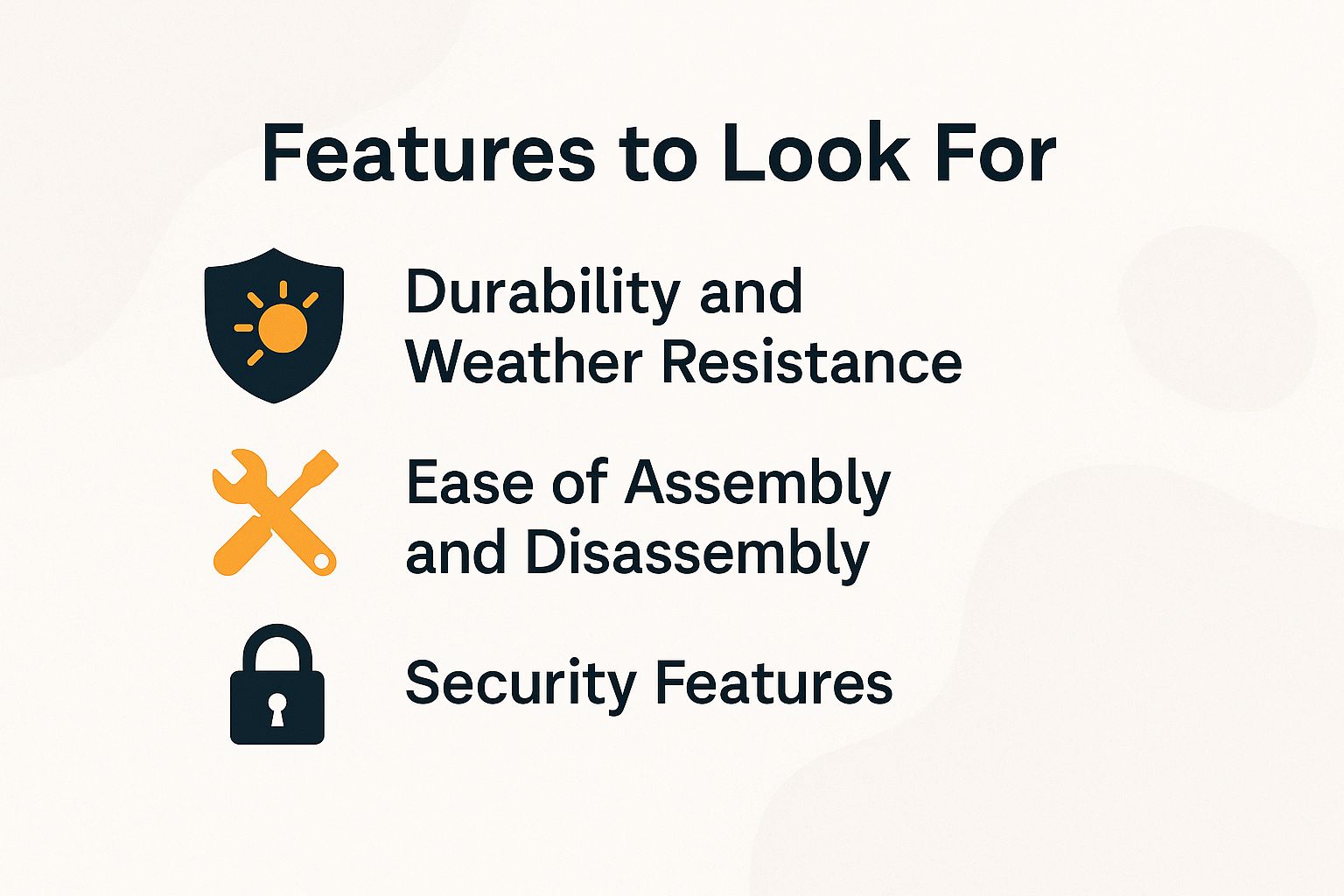
Look into climate control choices and personalized services for customized solutions.
Choosing the right temporary storage building means looking at important features that make it strong, safe, and easy to use, such as durability and security. For a comprehensive overview, you may want to explore the key features of portable guard shacks, which can offer valuable insights into essential characteristics of portable structures.
Durability and Weather Resistance
Carry out tests to check how long-lasting something is and think about what upkeep is needed to make it last.
Pick materials like galvanized steel or sturdy canvas for outdoor use that lasts a long time and can withstand the weather.
Galvanized steel is a good choice for constructing fences and storage sheds because it resists rust for a long period.
Durable canvas, great for tarps and tents, offers strong protection against water and sun, lasting much longer. For added assurance, choose materials that meet ASTM standards for durability.
Another option is polypropylene, known for its lightweight yet tough nature, often used in outdoor furniture. Selecting the right material can significantly impact the longevity and performance of your outdoor projects.
Ease of Assembly and Disassembly
Choose DIY storage solutions with clear assembly instructions for convenience.
Pick structures that are easy to put together; kits that take about 4 hours to set up are perfect for urgent needs.
Brands like Arrow provide excellent assembly instructions, often including clear step-by-step guides and visual aids. Customers consistently praise Arrow for its user-friendliness, with one user noting, “I assembled my shed in just under 4 hours with no prior experience!”
Another added, “The instructions were so clear, I didn’t need any additional tools.”
Using tools like a power drill and a level can speed up the assembly and help create a stable final product without the hassle of complex steps.
Security Features
Look for advanced security features including security cameras and alarms.
Security features like strong lock systems and motion sensor lights can greatly improve the safety of your stored items.
Using advanced security options protects your belongings and discourages theft. Leading brands with strong security features include:
- BOLLARD LOCKS ($150-$300) – Known for their durability and resistance to tampering.
- Ring Security Cameras ($199) – Provide real-time monitoring and alerts.
- ADT Motion Sensors (starting at $99) – Ideal for detecting unexpected movements.
These upgrades help you feel more confident, and the costs usually range from $150 to $600 depending on your choices.
Comparing Different Brands and Models
There are lots of brands in the temporary storage market, so check out their features, prices, and customer reviews to make a good choice. For a detailed comparison on renting storage buildings, (see our comprehensive guide on renting storage buildings and saving).
Top Brands in 2025
Look into the marketing tactics and specific customer groups targeted by top storage companies.
In 2025, the top brands for temporary storage include ShelterLogic, Rhino Shelter, and Tuff Shed, each offering unique advantages.
ShelterLogic is popular for its easy-to-carry, movable canopies, perfect for fast assembly and disassembly. Rhino Shelter, on the other hand, boasts rugged durability with weather-resistant materials, which appeals to users in harsher climates.
Tuff Shed stands out for its rigid construction and customizable storage options, perfect for those needing permanent solutions. Prices vary from $200 to $2,500 based on size and features. Consider your storage requirements and budget before deciding.
Customer Reviews and Ratings
Customer reviews highlight the importance of user experience, with ratings for temporary storage buildings averaging between 4 and 4.5 stars.
Common praises include easy assembly, durability, and efficient foundation requirements, with many users noting that buildings from brands like ShelterLogic and Arrow are particularly sturdy.
Complaints often center around inadequate customer service, delivery logistics, and missing parts upon delivery.
Customers recommend checking local stores for kits to minimize shipping issues and utilizing assembly videos available online.
Tools such as power drills can significantly expedite the setup process, ensuring a smoother experience overall, especially when considering eco-friendly materials and efficiency ratings.
Cost Analysis
Doing a detailed cost analysis helps you know both the upfront cost and ongoing expenses when picking temporary storage, including organization tips and size options.
Initial Purchase Costs
Initial purchase costs for temporary storage buildings can range from $1,500 for basic models to over $20,000 for advanced custom units, depending on construction materials.
When considering your options, assess your specific needs to maximize value. For example, a simple metal shed may suffice for garden tools, while a larger, insulated unit offers climate control for sensitive equipment.
Companies like Tuff Shed and Backyard Works provide customizable solutions to match personal requirements. Factor in delivery and installation costs, which can add $500 to $2,000 based on location and site preparation.
Prioritize your budget and functionality to find the perfect storage solution, while considering project planning and available accessories.
Maintenance and Upkeep Costs
Ongoing maintenance and upkeep can add $200-$600 annually, depending on the type of building and environmental exposure.
Common maintenance tasks include HVAC servicing, roof inspections, and landscaping, with an emphasis on environmental impact and insurance coverage.
For example, scheduling an HVAC tune-up might cost around $150 and should be done semi-annually, while a roof inspection can range from $100 to $300 depending on your roof type and size, following industry standards and ensuring customer support.
Budgeting for landscaping maintenance, like seasonal cleanups, might require $300 annually. When planning your yearly budget, consider allocating $1,000 to cover routine repairs, emergency fund contributions, and unexpected issues that may arise.
Where to Buy Temporary Storage Buildings
Buying temporary storage buildings is very simple now, with choices available from online stores to local suppliers and makers, offering a variety of aesthetic designs and mobile storage units. For further exploration, discover where to buy portable buildings and find the most convenient suppliers for your needs.
Online Retailers
Popular online retailers like Amazon, Wayfair, and Home Depot offer a diverse selection of temporary storage buildings at competitive prices.
Along with these, Lowe’s and Tractor Supply also provide various options.
Lowe’s carries units like the Arrow Shed (approximately $500), perfect for storing garden tools, while Tractor Supply offers budget-friendly choices, such as the Suncast Shed ($300), ideal for small items.
Amazon offers different models, such as the Keter Factor 6×3 storage shed, costing about $400 and appreciated for its ability to withstand various weather conditions, providing storage unit comparisons and referencing online marketplaces.
Check the warranties, delivery choices, and customer feedback on each website to pick the most suitable option for you, utilizing online resources and expert consultations.
Local Suppliers and Manufacturers
Local suppliers offer individual service and usually have choices suitable for local requirements, following regional rules and offering do-it-yourself storage options.
Getting products from nearby vendors can greatly improve how your business runs. For instance, partnering with manufacturers like Shurtleff & Associates in California for specialty coffee or Fletts in Michigan for custom metal fabrication allows you to reduce shipping costs and times.
Local suppliers can quickly change order amounts or details when needed. Tools like ThomasNet can help you locate reputable local manufacturers, while attending regional trade shows can provide networking opportunities with suppliers who understand your specific market requirements.

About the Author
I’m James Holloway, a Texas A&M University graduate with a degree in Construction Engineering and the owner of a successful prefab office building company in Texas. For the past 12 years, I’ve helped businesses across the state create efficient, compliant, and cost-effective portable office solutions that work as hard as they do. As a contributor to US Construction Trailers, I focus on helping business owners make smart investments in modular space.
